Coco coir is a versatile and sustainable medium for growing microgreens, offering numerous benefits for successful cultivation. It is derived from the fibrous husk of coconuts and has gained popularity among growers due to its organic nature and excellent water retention properties. Whether used as a stand-alone medium or mixed with other substances like soil or perlite, coco coir provides an ideal environment for microgreen growth.
Key Takeaways:
- Coco coir is a 100% organic medium that is ideal for growing microgreens.
- It retains water well while maintaining good drainage, providing an optimal growing environment.
- Coconut coir has a neutral pH, which is beneficial for the establishment and growth of microgreens.
- Using coco coir as a stand-alone medium or mixing it with other substances like soil or perlite can improve texture and drainage.
- While coco coir lacks nutrients, it can be supplemented with fertilizers to provide essential nutrition for microgreens.
In this comprehensive guide, we will explore the various aspects of using coco coir for growing microgreens. From the different types of coco coir available to the process of preparing it for microgreen cultivation, we will cover everything you need to know to achieve successful and sustainable results. Whether you are a beginner or an experienced grower, this guide will provide you with valuable insights and practical tips for using coco coir as a growing medium for microgreens.
Benefits of Coco Coir for Microgreens
Coconut coir has several advantages that make it an ideal medium for growing microgreens. Firstly, it is 100% organic, making it a natural and sustainable choice for environmentally conscious growers. Additionally, coconut coir retains water exceptionally well while also providing excellent drainage, ensuring that your microgreens receive the perfect balance of moisture. This ability to retain water is particularly beneficial in dry or arid climates where water conservation is crucial.
A neutral pH is another notable benefit of coconut coir. Microgreens thrive in a pH range of 6 to 7, and coconut coir falls within this ideal range, creating a favorable environment for plant growth. Moreover, coconut coir is odorless and free of bacteria, reducing the risk of disease and ensuring a clean and hygienic growing medium.
One of the key advantages of coconut coir is its ability to promote strong root growth. The fibrous structure of coir provides ample oxygenation and aeration for the roots, allowing them to develop robustly. Strong root systems are essential for healthy and vigorous microgreen growth, resulting in higher yields and superior quality greens.

Table 1: Comparison of Different Types of Coconut Coir for Microgreens
| Type of Coconut Coir | Characteristics |
|---|---|
| Coco Peat/Coir | High water retention, suitable for varieties requiring more moisture |
| Coco Fibers | Good drainage, suitable for varieties requiring less moisture |
| Coco Chips | Enhanced aeration, provides excellent drainage |
Table 1 illustrates the different types of coconut coir available for microgreen cultivation and their unique characteristics. Coco peat/coir is an excellent choice for varieties that require higher moisture levels, while coco fibers are ideal for those that prefer less moisture. Coco chips are particularly suited for microgreens that benefit from enhanced aeration and excellent drainage.
Types of Coconut Coir for Microgreens
There are several types of coconut coir available for microgreen growing, including coco peat/coir, coco fibers, and coco chips. Each type has its own unique characteristics that make it suitable for different microgreen cultivation needs. Coco peat/coir is a fine texture coconut coir that is often used as a growing medium for microgreens. It has excellent water retention properties and provides good drainage, which is crucial for plant health. Coco fibers, on the other hand, have a more fibrous texture and are often used in hydroponic systems or as a base layer in pots or trays. They provide good aeration and moisture control, allowing roots to thrive. Lastly, coco chips are larger pieces of coconut coir that promote better airflow and drainage. They are ideal for growing microgreens that require a drier environment or for use as a top dressing for added insulation.
| Type of Coconut Coir | Characteristics |
|---|---|
| Coco peat/coir | Fine texture, good water retention, and drainage |
| Coco fibers | Fibrous texture, excellent aeration and moisture control |
| Coco chips | Larger pieces, better airflow and drainage |
Choosing the right type of coconut coir for your microgreens depends on the specific needs of your plants and the growing environment. Coco peat/coir is a versatile option that works well for a wide range of microgreens. Coco fibers are ideal for hydroponic systems or those seeking optimal root development, while coco chips are suitable for plants that prefer a drier environment. By understanding the characteristics of each type, you can select the coconut coir that best suits your microgreen cultivation goals.
Using Coco Peat/Coir for Microgreens
Coco peat/coir is one of the most commonly used types of coconut coir for microgreens. Its fine texture allows for good water retention and drainage, which are essential for successful microgreen growth. To maximize its benefits, you can soak compressed bricks of coco peat/coir in water until they expand and become fluffy. This process helps break down any compacted fibers and allows for better aeration and moisture absorption. After fluffing the coco peat/coir, you can mix it with perlite for added drainage and then fill up your trays or pots with the mixture before adding your microgreen seeds. This combination of coco peat/coir and perlite provides a balanced growing medium that supports healthy root development and overall plant growth.

The image above showcases coco peat/coir, one of the popular types of coconut coir for microgreen cultivation. Its fine texture and excellent water retention make it a versatile and reliable choice for growing microgreens.
Preparing Coco Coir for Microgreens
Properly preparing coco coir is essential for successful microgreen cultivation. Coco coir, derived from coconut husks, is a versatile growing medium that provides numerous benefits for microgreens. Before using coco coir, it is important to follow a few steps to ensure its readiness for planting. Here is a simple guide on how to prepare coco coir for microgreens.
The first step is to determine the desired size of the growing mat. Coco coir usually comes in compressed bricks or blocks, which need to be soaked in water to expand and fluff up. Place the brick in a container filled with water, ensuring it is fully submerged. Allow it to soak for about 30 minutes, or until the brick has expanded and softened.
After soaking, gently break apart the expanded coco coir brick and fluff it up using your hands or a gardening fork. This process helps to loosen the fibers and create a light and airy texture. For optimal drainage, it is recommended to mix the fluffed coco coir with perlite. Perlite is a lightweight volcanic rock that enhances aeration and prevents compaction.
Once the coco coir is fluffed and mixed with perlite, it is ready to be used as a growing medium. Fill up a tray or container with the prepared coco coir mixture, ensuring it is evenly distributed. Use a gardening tool to smooth and level the surface. Now, it’s time to add the microgreen seeds onto the coco coir surface. Gently press the seeds into the coir, ensuring they make contact with the substrate.
Table: Step-by-Step Guide to Preparing Coco Coir for Microgreens
| Step | Description |
|---|---|
| Step 1 | Determine the desired size of the growing mat. |
| Step 2 | Soak the compressed coco coir brick in water until it expands. |
| Step 3 | Fluff up the expanded coco coir with your hands or a gardening fork. |
| Step 4 | Mix the fluffed coco coir with perlite for improved drainage. |
| Step 5 | Fill up a tray with the prepared coco coir mixture. |
| Step 6 | Add microgreen seeds onto the coco coir surface and gently press them in. |
By following these steps, you can properly prepare coco coir as a growing medium for microgreens. Remember to water the coco coir regularly and provide adequate lighting for optimal growth. Enjoy the rewarding experience of cultivating vibrant and nutritious microgreens with coco coir.
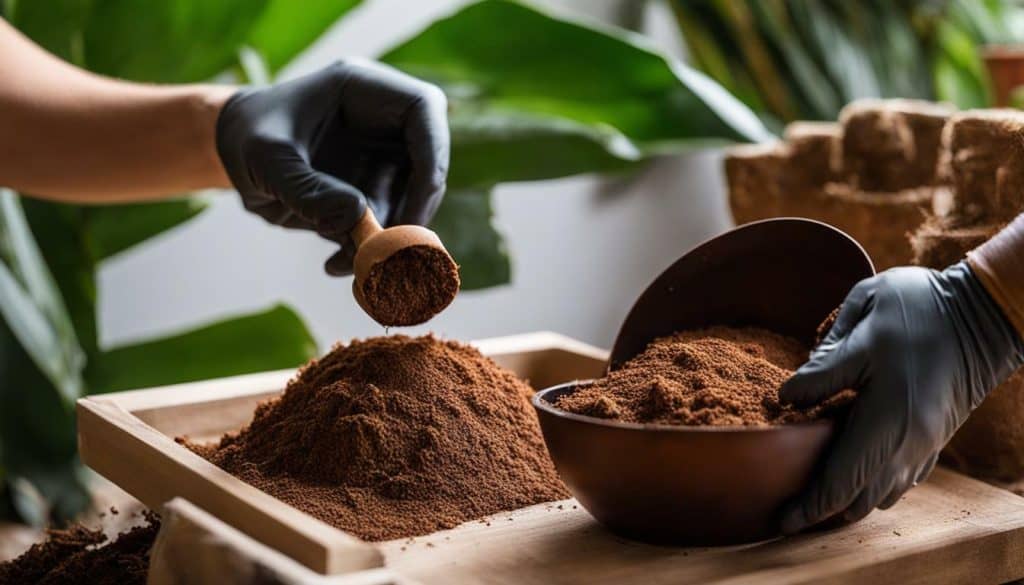
Coco coir can be used as a stand-alone medium for growing microgreens, providing a clean and natural base for plant growth. This organic material has numerous advantages that contribute to optimal microgreen cultivation. Coco coir retains water well, ensuring adequate moisture for the plants, while also providing excellent drainage to prevent waterlogging. Its neutral pH level creates a favorable environment for microgreen growth, and the absence of odor and bacteria promotes healthy and disease-free plants. Additionally, coco coir promotes strong root growth, which is crucial for the overall development of microgreens.
When using coco coir as a stand-alone medium, it’s important to consider the nutritional needs of microgreens. While coco coir itself does not contain many nutrients, it can be supplemented with fertilizers to provide the necessary elements for plant growth. Adding a balanced fertilizer specifically formulated for microgreens can help ensure they receive the essential nutrients they require. It is recommended to follow the instructions provided by the fertilizer manufacturer for the correct application and dosage.
In summary, using coco coir as a stand-alone medium for growing microgreens is a practical and natural choice. Its benefits include water retention, drainage, neutral pH, lack of odor and bacteria, and promotion of strong root growth. By supplying the appropriate nutrients through fertilizers, microgreens can thrive in coco coir, resulting in healthy, flavorful, and nutritious harvests.
Table 1: Comparison of Coco Coir as a Stand-Alone Medium and Other Growing Mediums
| Growing Medium | Water Retention | Drainage | pH Level | Odor and Bacteria | Root Growth |
|---|---|---|---|---|---|
| Coco Coir | High | Excellent | Neutral | None | Strong |
| Soil | Variable | Variable | Variable | Potential | Variable |
| Hydroponics | Controlled | Controlled | Controlled | None | Variable |

Mixing Coco Coir with Soil or Perlite
Mixing coco coir with soil or perlite can enhance the growing conditions for microgreens, resulting in healthier plants. Coco coir is known for its excellent water retention and drainage properties, which are beneficial for the root development of microgreens. By incorporating coco coir into your growing medium, you can improve the texture and moisture control of the soil, promoting optimal growth.
When mixing coco coir with soil, it is recommended to use a ratio of 1 part coco coir to 2 parts soil. This ensures that there is enough coco coir to provide the desired benefits without compromising the nutrient content of the soil. The mixture should be thoroughly blended to ensure even distribution.
If you prefer to use perlite instead of soil, a similar ratio can be applied. The addition of coco coir helps to improve the moisture retention of the perlite, preventing it from drying out too quickly. This combination also improves the overall drainage system, allowing excess water to flow through and preventing the roots from becoming waterlogged.
It is important to note that when using coco coir, it is advisable to monitor the moisture levels of the growing medium regularly. Coco coir has a high water-holding capacity, which means that it may retain more moisture than other mediums. Adjustments to watering frequency may be necessary to prevent overwatering and ensure the optimal moisture balance for microgreen growth.
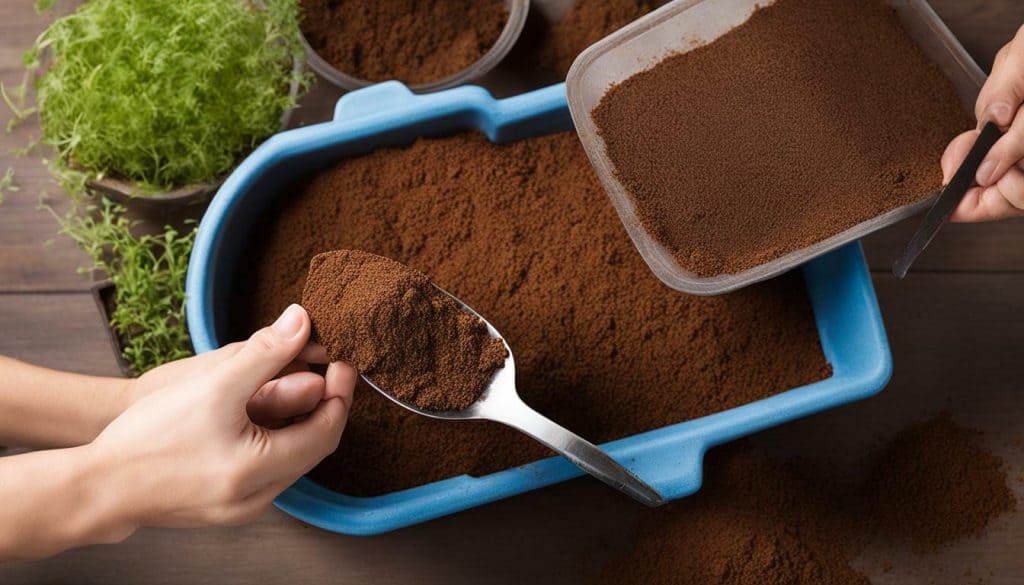
| Benefits of Mixing Coco Coir with Soil or Perlite |
|---|
| Improved water retention and drainage |
| Enhanced texture and moisture control |
| Optimal root development and overall plant health |
| Prevents soil compaction and improves aeration |
| Reduces the risk of overwatering and root rot |
Nutritional Considerations for Coco Coir
While coco coir offers many benefits for microgreen growth, it lacks significant nutrient content, requiring the addition of fertilizers for optimal plant nutrition. Coco coir is a great growing medium due to its water retention and drainage properties, as well as its ability to promote strong root growth. However, since it is derived from coconut husks, which are naturally low in nutrients, microgreens grown solely in coco coir may not receive adequate nutrition to reach their full potential.
When using coco coir for microgreens, it is essential to supplement the medium with fertilizers to provide the necessary nutrients for healthy plant growth. Fertilizers can be added during the soaking process or applied later during the growing cycle. By adding fertilizers, microgreens can access the essential macronutrients and micronutrients they need to thrive.
It is recommended to use a balanced water-soluble fertilizer specifically formulated for hydroponic or soilless growing. This type of fertilizer contains a blend of essential nutrients, such as nitrogen, phosphorus, and potassium, as well as trace elements like iron, manganese, and zinc. Follow the manufacturer’s instructions for the appropriate dilution and application rate based on the stage of growth and specific microgreen variety.
By supplementing coco coir with fertilizers, you can ensure your microgreens receive the necessary nutrition for healthy growth and development. This combination of a nutrient-rich fertilizer and the excellent growing properties of coco coir creates an ideal environment for thriving microgreens.
Nutritional Considerations for Coco Coir:
- Coco coir lacks significant nutrient content, requiring the addition of fertilizers for optimal plant nutrition.
- Supplement coco coir with a balanced water-soluble fertilizer specifically formulated for hydroponic or soilless growing.
- Fertilizers provide essential macronutrients and micronutrients for healthy microgreen growth.
- Follow the manufacturer’s instructions for the appropriate dilution and application rate based on the stage of growth and specific microgreen variety.
| Nutrient | Function |
|---|---|
| Nitrogen (N) | Supports leafy growth and overall plant vigor. |
| Phosphorus (P) | Promotes root development, flower formation, and seed production. |
| Potassium (K) | Facilitates nutrient absorption, aids in disease resistance, and improves overall plant health. |
| Calcium (Ca) | Strengthens cell walls and improves stem and leaf structure. |
| Magnesium (Mg) | Essential for chlorophyll production and photosynthesis. |
| Sulfur (S) | Important for protein synthesis and enzyme activity. |
| Iron (Fe) | Crucial for chlorophyll formation and overall plant growth. |
| Manganese (Mn) | Enzyme activator involved in various plant metabolic processes. |
| Zinc (Zn) | Essential for enzyme function and hormone regulation. |

Although coco coir is an excellent medium for microgreen cultivation, it does have a few potential downsides that should be considered. One of the main drawbacks is that coco coir contains few nutrients on its own. While it retains water well and provides good drainage, it lacks essential nutrients that microgreens need to thrive. Therefore, if you choose to use coco coir as a stand-alone medium, it is crucial to supplement it with fertilizers to ensure optimal growth and development of your microgreens.
Another potential issue with coco coir is the presence of excess salt. Sometimes, coco coir can have salt residues that were not properly rinsed out during the manufacturing process. This excess salt can be harmful to microgreens and inhibit their growth. To avoid this problem, it is recommended to thoroughly rinse the coco coir before use, ensuring that any excess salt is removed.
Despite these downsides, it’s important to note that with proper care and preparation, these issues can be mitigated. By adding fertilizers to provide the necessary nutrients and rinsing the coco coir to remove excess salt, you can create an optimal environment for growing healthy and vibrant microgreens. Coco coir remains a popular choice for microgreen cultivation due to its many benefits and its sustainable and environmentally friendly nature.
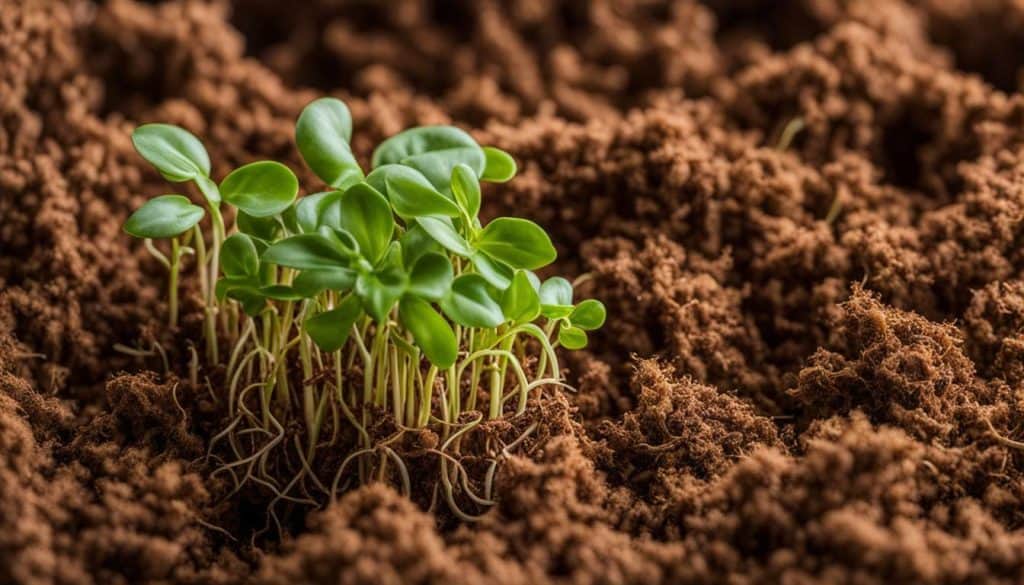
| Pros | Cons |
|---|---|
| 100% organic | Limited nutrient content |
| Retains water well | Potential for excess salt |
| Provides good drainage | |
| Neutral pH | |
| Odorless and bacteria-free | |
| Promotes strong root growth |
Sustainability of Coco Coir for Microgreens
Choosing coco coir as a growing medium for microgreens aligns with sustainable gardening practices, offering an eco-friendly solution. Coco coir is derived from the husks of coconuts, making it a renewable and organic resource. Its production has minimal impact on the environment, as it does not require the cutting down of trees or the use of harmful chemicals.
Furthermore, coco coir is biodegradable, meaning it will naturally break down over time without leaving any harmful residues. This makes it a perfect choice for those looking to minimize their ecological footprint while still achieving optimal growth for their microgreens.
Table: Environmental Benefits of Coco Coir
| Benefit | Description |
|---|---|
| Organic and Renewable | Coco coir is a natural byproduct of coconut processing and can be continuously produced without depleting natural resources. |
| Biodegradable | Once discarded, coco coir will decompose naturally and return to the environment, leaving behind no harmful residues. |
| Reduces Waste | Using coco coir as a growing medium helps reduce waste by repurposing a byproduct that would otherwise go to landfill. |
When combined with other sustainable practices such as water conservation and organic pest control, coco coir can contribute to a more environmentally friendly approach to microgreen cultivation. By choosing coco coir as a growing medium, you are not only providing optimal conditions for your microgreens but also taking a step towards a greener and more sustainable future.
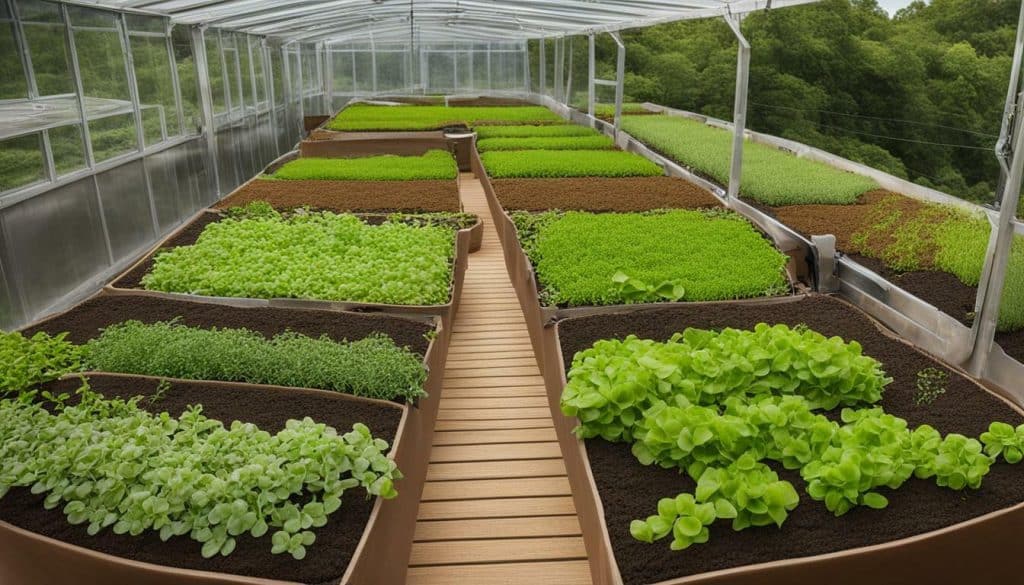
Selecting the appropriate type of coco coir is crucial for successful microgreen cultivation. Coco coir comes in different forms, each with its own unique characteristics. Understanding these options will help you make an informed decision and optimize your microgreen growth.

One common type of coco coir is coco peat or coco coir. It is made from the outer husk of coconuts and is known for its high water retention capabilities. Coco peat is ideal if you’re looking for a medium that holds moisture well, allowing your microgreens to stay hydrated. On the other hand, coco fibers offer excellent aeration and drainage properties, making them suitable for microgreens that prefer a drier environment.
Coco chips are another option to consider. These larger pieces of coconut coir provide good airflow to the roots while retaining enough moisture. They are especially beneficial for microgreens with longer growing times or those that require extra root space.
| Type of Coco Coir | Characteristics | Microgreens Suitable For |
|---|---|---|
| Coco Peat/Coir | High water retention | Microgreens that require consistent moisture |
| Coco Fibers | Excellent aeration and drainage | Microgreens that prefer a drier environment |
| Coco Chips | Good airflow and moisture retention | Microgreens with longer growing times or need more root space |
Consider the specific needs of your microgreens when choosing the right coco coir. Experimenting with different types can help you find the one that best suits your preferred microgreen varieties and growing conditions.
Tips for Growing Microgreens in Coco Coir
Growing microgreens in coco coir requires specific attention to ensure optimal conditions for plant growth. Coco coir, being 100% organic and providing excellent water retention and drainage, is an ideal substrate for microgreen cultivation. Here are some tips to help you successfully grow microgreens in coco coir.
- Choose the right coco coir: Select a high-quality coco coir product that suits your microgreen variety and growing method. Consider factors such as water-holding capacity, fiber length, and consistency to ensure the best results.
- Soak the coco coir: Before planting your microgreen seeds, soak the coco coir in water to hydrate it. This will ensure that the coir is evenly moist and ready to support seed germination and growth.
- Control moisture levels: Coco coir retains water well, but it’s important to strike a balance. Avoid overwatering, which can lead to root rot and other issues. Aim for slightly moist, but not waterlogged, conditions for your microgreens.
- Provide adequate lighting: Microgreens need proper light to thrive. Place them in a location with bright, indirect sunlight or use grow lights to ensure they receive the right amount of light for photosynthesis.
- Monitor temperature and humidity: Microgreens prefer warm temperatures and moderate humidity. Maintain a temperature range of 60-75°F (15-24°C) and humidity levels around 40-60% for optimal growth.
Following these tips will help you create a favorable environment for your microgreens to flourish in coco coir. Remember to regularly check the moisture levels, provide adequate lighting, and maintain optimal temperature and humidity conditions. With proper care and attention, you can enjoy a bountiful harvest of nutritious and delicious microgreens.
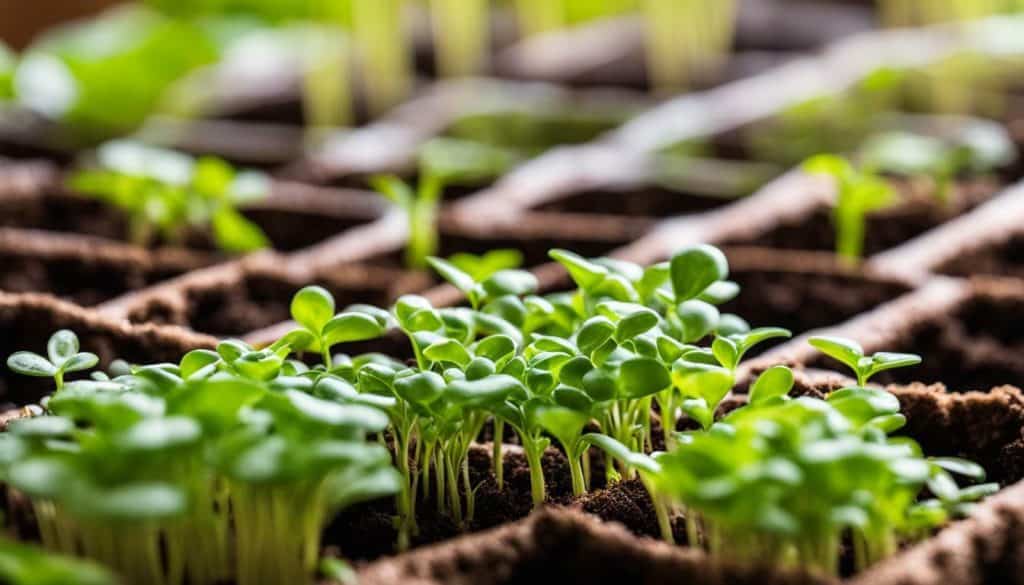
Reusing coco coir as a growing medium for microgreens is an economical and sustainable practice that can yield excellent results. By following a few best practices, you can extend the lifespan of your coco coir and reduce waste. Here are some tips for reusing coco coir:
1. Cleaning and Reconditioning:
After harvesting your microgreens, remove the remaining roots and debris from the used coco coir. Rinse the coir thoroughly to remove any excess nutrients and salts. Soak the coir in fresh water for a few hours to leach out any remaining impurities. Then, allow the coir to dry completely before reusing it. This reconditioning process ensures that the coco coir is clean and ready for the next batch of microgreens.
2. Nutrient Supplementation:
Coco coir alone does not provide sufficient nutrients for microgreens. To ensure healthy growth and optimal yields, it’s essential to supplement the reused coco coir with additional nutrients. You can achieve this by mixing in organic fertilizers or using a liquid nutrient solution when watering your microgreens. This way, you provide the necessary nutrition for the new crop while maximizing the benefits of reusing coco coir.
3. Proper Storage:
When not in use, store the cleaned and dried coco coir in a dry and airtight container to prevent mold or mildew growth. Make sure the container is free from moisture and pests. Keeping the coco coir in a suitable storage environment prolongs its shelf life and maintains its quality for future use.
Table: Coco Coir Reuse Guidelines
| Step | Action |
|---|---|
| 1 | Clean and rinse the coco coir to remove debris and excess salts. |
| 2 | Soak the coco coir in fresh water to leach out impurities. |
| 3 | Dry the coco coir completely before reuse. |
| 4 | Supplement the reused coco coir with organic fertilizers or liquid nutrients. |
| 5 | Store the cleaned and dried coco coir in a dry and airtight container. |
By following these best practices, you can make the most of your coco coir, reduce waste, and contribute to a more sustainable approach to microgreen cultivation.
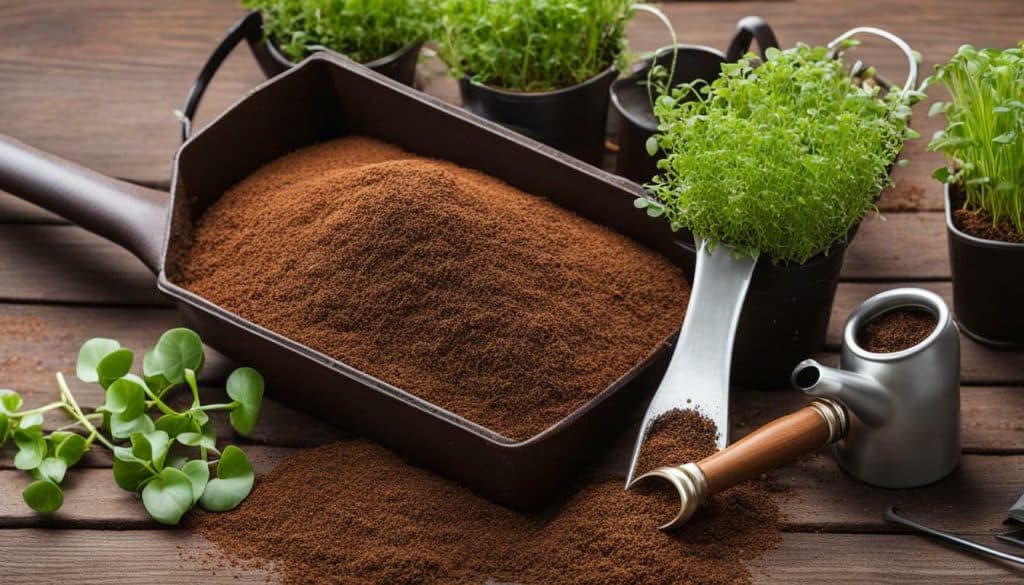
Coco coir is a favored medium for growing a variety of delicious and nutritious microgreens. Its unique properties make it an ideal choice for cultivating these miniature greens, providing them with the optimal conditions for growth. Whether you are a seasoned microgreen grower or just starting out, here are some popular microgreens that thrive when grown in coco coir.
1. Broccoli Sprouts
Broccoli sprouts are packed with nutrients and have a distinct and delicious flavor. They are rich in antioxidants, vitamins, and minerals, making them a popular choice among health-conscious individuals. When grown in coco coir, these sprouts develop strong and vibrant leaves, adding a vibrant touch to salads, sandwiches, and other dishes.
2. Pea Shoots
Pea shoots are delicate and tender greens with a slightly sweet taste. They are a great source of vitamins A, C, and K, as well as fiber and folate. Grown in coco coir, pea shoots develop long, curly tendrils and soft leaves, adding a fresh and crisp texture to any dish.
3. Sunflower Sprouts
Sunflower sprouts are known for their nutty flavor and crunchy texture. They are packed with vitamins and minerals, including vitamin E, magnesium, and selenium. When grown in coco coir, sunflower sprouts produce vibrant green leaves and develop a subtle sweetness, making them a versatile addition to salads, sandwiches, and smoothies.
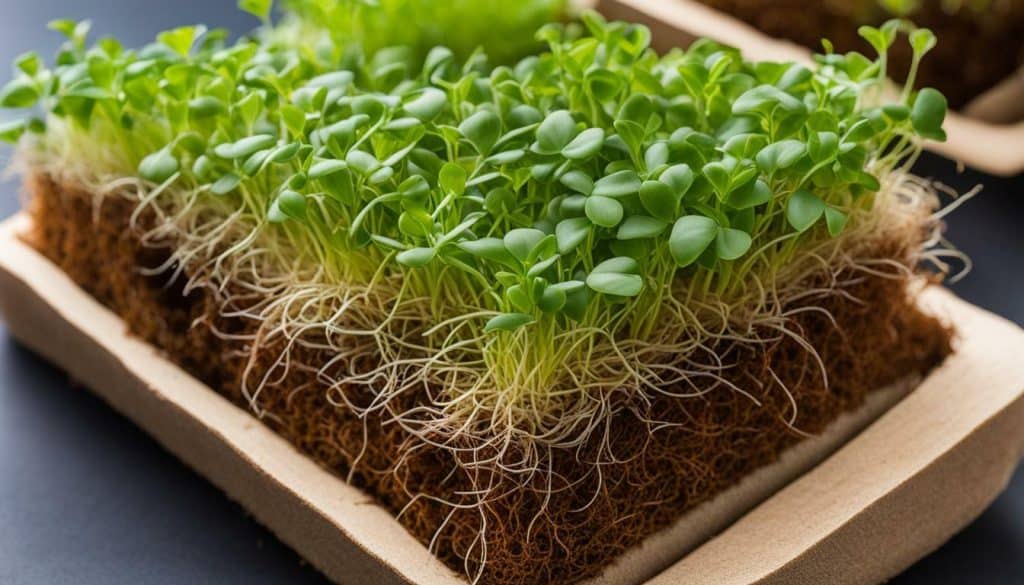
Radish microgreens add a peppery kick to dishes and are rich in vitamin C, potassium, and antioxidants. Grown in coco coir, these microgreens develop vibrant red stems and green leaves, providing a burst of color and flavor to salads, sandwiches, and even stir-fries.
These are just a few examples of the many microgreens that thrive when grown in coco coir. Experiment with different varieties to discover your favorites and enjoy the fresh, nutritious taste of homegrown microgreens!
| Microgreen | Flavor | Nutrients |
|---|---|---|
| Broccoli Sprouts | Distinct, delicious | Antioxidants, vitamins, minerals |
| Pea Shoots | Slightly sweet | Vitamins A, C, K, fiber, folate |
| Sunflower Sprouts | Nutty | Vitamin E, magnesium, selenium |
| Radish Microgreens | Peppery | Vitamin C, potassium, antioxidants |
Conclusion
Coco coir is an excellent choice for microgreen cultivation, offering numerous benefits for successful and sustainable plant growth. As a 100% organic medium, coco coir provides a range of advantages that contribute to the optimal development of microgreens.
One of the key benefits of coco coir is its ability to retain water while maintaining excellent drainage. This ensures that microgreens receive the right amount of moisture without becoming waterlogged. Additionally, coco coir has a neutral pH, making it suitable for a wide range of microgreen varieties.
Another advantage of coco coir is its odorless and bacteria-free nature. This reduces the risk of contamination and promotes a healthy growing environment for microgreens. Furthermore, coco coir promotes strong root growth, allowing microgreens to establish a robust root system and absorb nutrients efficiently.
Whether used as a stand-alone medium or mixed with soil or perlite, coco coir provides a versatile option for microgreen cultivation. Its different types, such as coco peat/coir, coco fibers, and coco chips, offer flexibility to meet specific growing needs.
While coco coir does not contain many nutrients on its own, the addition of fertilizers ensures that microgreens receive the necessary nutrition for optimal growth. It is worth noting that coco coir may have limited nutrient content and may contain excess salt if not rinsed properly. However, with proper care and preparation, these downsides can be mitigated.
In conclusion, coco coir is a sustainable and environmentally friendly choice for growing microgreens. Its organic nature, water retention, drainage capabilities, and promotion of strong root growth make it an ideal medium for successful microgreen cultivation. By considering the different types of coco coir and using appropriate fertilizers, microgreen enthusiasts can maximize the potential of coco coir in their gardening practices.
FAQ
Q: What are the benefits of using coco coir for microgreens?
A: Coco coir is 100% organic, retains water well while maintaining excellent drainage, has a neutral pH, is odorless and bacteria-free, and promotes strong root growth.
Q: What types of coconut coir can be used for microgreens?
A: There are different types of coconut coir, including coco peat/coir, coco fibers, and coco chips, each with their unique characteristics.
Q: How do you prepare coco coir for microgreens?
A: Coco coir can be prepared by cutting it to size and soaking it in water, or by soaking compressed bricks in water, fluffing the coir, and mixing it with perlite before filling up a tray and adding seeds.
Q: Can coco coir be used as a stand-alone medium for microgreens?
A: Yes, coco coir can be used as a stand-alone medium for microgreens, but it may require the addition of fertilizers to provide necessary nutrients.
Q: Can coco coir be mixed with soil or perlite?
A: Yes, coco coir can be mixed with soil or perlite to improve texture and drainage in the growing medium for microgreens.
Q: Does coco coir provide enough nutrients for microgreens?
A: No, coco coir does not contain many nutrients on its own, so fertilizers may need to be added when using it as a stand-alone medium.
Q: What are the potential downsides of using coco coir for microgreens?
A: Some potential downsides include the limited nutrient content and the possibility of excess salt if the coir is not rinsed properly.
Q: Is coco coir a sustainable option for growing microgreens?
A: Yes, coco coir is a sustainable and environmentally friendly option, being organic, renewable, and biodegradable.
Q: How do you choose the right coco coir for microgreens?
A: Factors such as coco mat hydroponics and the specific microgreen variety can help guide the choice of the right coco coir.
Q: What are the best practices for reusing coco coir?
A: Coco coir can be reused as a growing medium for microgreens by cleaning and reconditioning it properly.
Q: Which microgreens grow well in coco coir?
A: Several microgreens thrive when grown in coco coir, including examples such as sunflower shoots, pea shoots, and radish microgreens.
